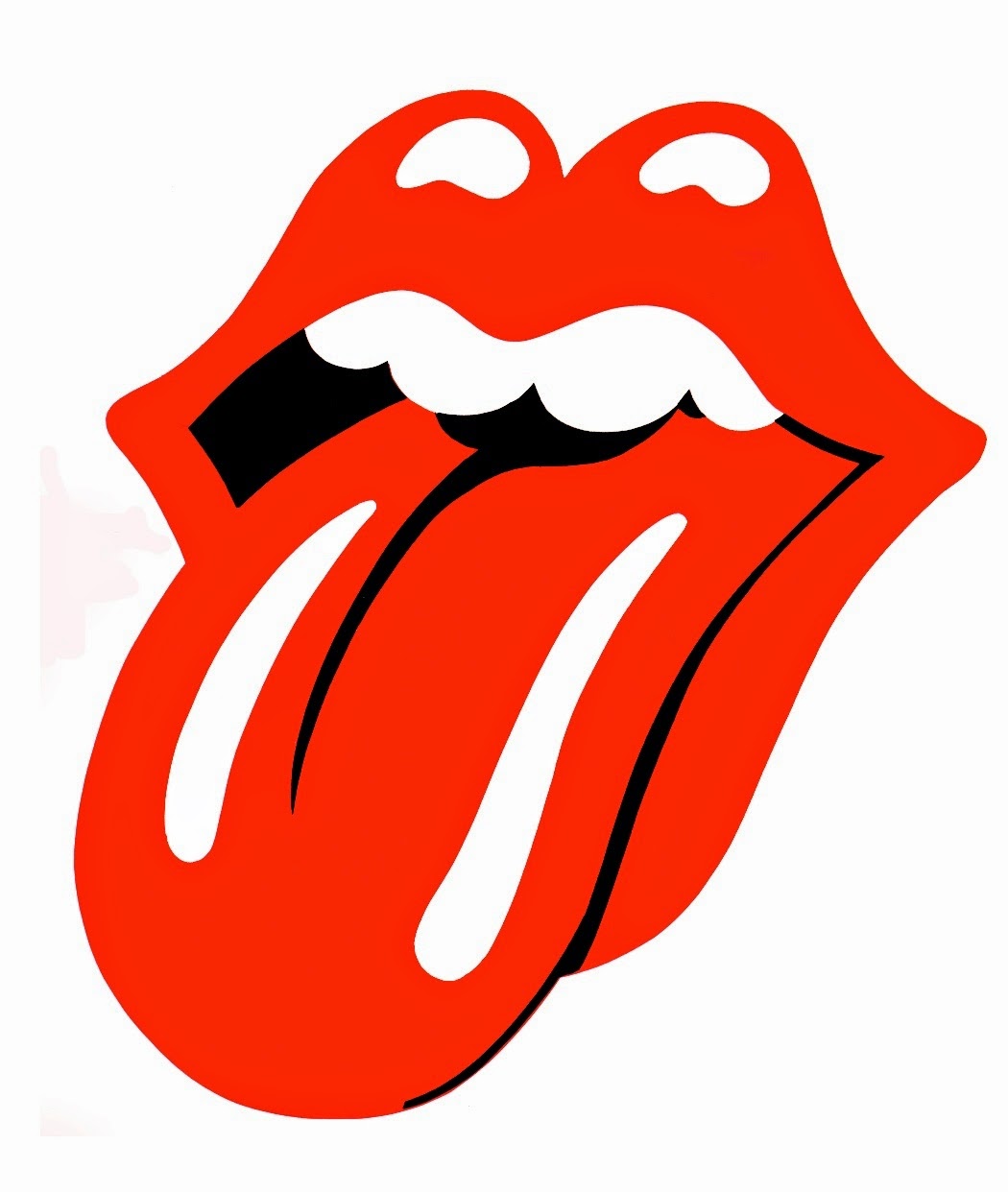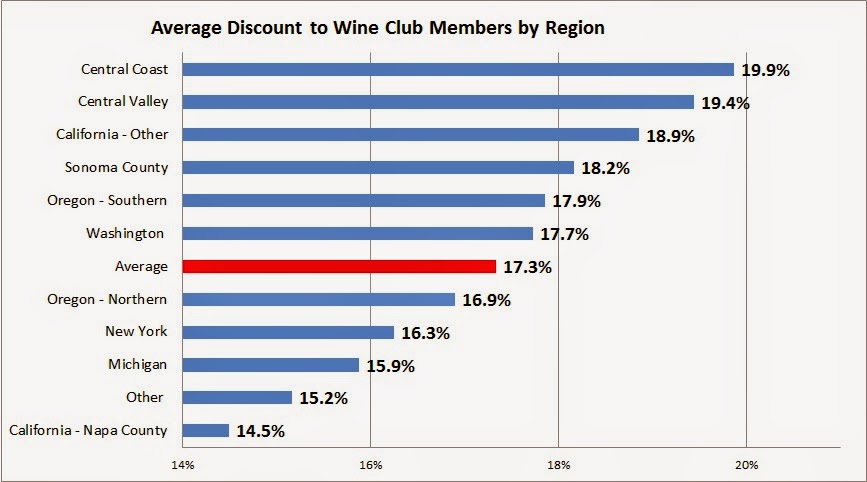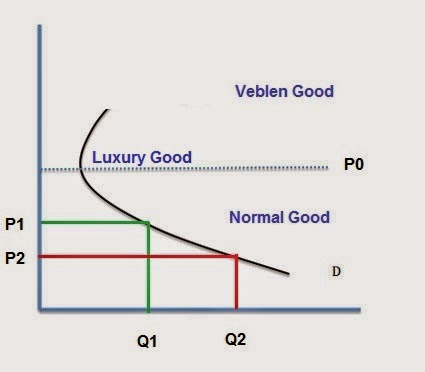
I'm betting nobody knows who Thorstein Veblen is. Like this picture, you have to be a little cockeyed to know him; be a Jeopardy Champion, enjoy thumbing through pictures of people who look like axe murderers, or maybe you are an economist with little to do with your free time except refresh your memory about a Veblen good?
One on-going debate in the wine business where Veblen's theories play a role is price discounts. Should you discount, and if so when and by how much? To get at an answer we'll review some economic basics. (... I know how exciting that sounds but stick with it. I won't kill you with math.)
The Rolling Stones Know Veblen
Normal goods are those goods that when income increases, demand increases. Inferior goods are those goods which when income increases, demand decreases. Inferior is not a statement of the good's quality, only the relative direction of negative change when income increases.
Wine as an industry product has both normal and inferior properties. During recessions, we see "trading down" of more expensive wines into wines of lesser price. When income increases as we are seeing today, the opposite happens and we see "trading up."
With a luxury good, as income increases, demand for that good increases proportionally more. A Veblen good is a special kind of luxury good like some perfume where a decrease in price can lead to a decline in demand ..... which seems to go against conventional economic wisdom. Nonetheless, some luxury goods perform just that way .... and without getting into a discussion of the marginal income elasticity for the wealthy class, when it comes to discounting luxury, superior and Veblen goods, consider this example:
 You see a bottle of wine in Safeway. Its a brand you've enjoyed often before at $25. This same bottle is now on the shelf on discount for $4.99 and there is a whole end-cap full of the brand. What do you do? With a price now 1/5th that of the old price, do you buy 5 times more wine? Nope. You question your memory and go buy something for $25. That's an example of a good reacting in the reverse to a discount. Its the "you get what you pay for" adage entering your purchase behavior.
You see a bottle of wine in Safeway. Its a brand you've enjoyed often before at $25. This same bottle is now on the shelf on discount for $4.99 and there is a whole end-cap full of the brand. What do you do? With a price now 1/5th that of the old price, do you buy 5 times more wine? Nope. You question your memory and go buy something for $25. That's an example of a good reacting in the reverse to a discount. Its the "you get what you pay for" adage entering your purchase behavior.
I'm pretty sure when The Rolling Stones sang "You can't always get what you want," the song was written about scarcity and Veblen goods, because - if you could always get what you wanted - like air for instance, then you wouldn't pay anything for it even if having it is a life or death issue. And since drinking good wine is a life and death issue, that gets us back to the question of this post: Should you ever discount your wine?
The Rolling Stones Know Veblen
Normal goods are those goods that when income increases, demand increases. Inferior goods are those goods which when income increases, demand decreases. Inferior is not a statement of the good's quality, only the relative direction of negative change when income increases.
Wine as an industry product has both normal and inferior properties. During recessions, we see "trading down" of more expensive wines into wines of lesser price. When income increases as we are seeing today, the opposite happens and we see "trading up."
With a luxury good, as income increases, demand for that good increases proportionally more. A Veblen good is a special kind of luxury good like some perfume where a decrease in price can lead to a decline in demand ..... which seems to go against conventional economic wisdom. Nonetheless, some luxury goods perform just that way .... and without getting into a discussion of the marginal income elasticity for the wealthy class, when it comes to discounting luxury, superior and Veblen goods, consider this example:
 You see a bottle of wine in Safeway. Its a brand you've enjoyed often before at $25. This same bottle is now on the shelf on discount for $4.99 and there is a whole end-cap full of the brand. What do you do? With a price now 1/5th that of the old price, do you buy 5 times more wine? Nope. You question your memory and go buy something for $25. That's an example of a good reacting in the reverse to a discount. Its the "you get what you pay for" adage entering your purchase behavior.
You see a bottle of wine in Safeway. Its a brand you've enjoyed often before at $25. This same bottle is now on the shelf on discount for $4.99 and there is a whole end-cap full of the brand. What do you do? With a price now 1/5th that of the old price, do you buy 5 times more wine? Nope. You question your memory and go buy something for $25. That's an example of a good reacting in the reverse to a discount. Its the "you get what you pay for" adage entering your purchase behavior.I'm pretty sure when The Rolling Stones sang "You can't always get what you want," the song was written about scarcity and Veblen goods, because - if you could always get what you wanted - like air for instance, then you wouldn't pay anything for it even if having it is a life or death issue. And since drinking good wine is a life and death issue, that gets us back to the question of this post: Should you ever discount your wine?
Discounts versus Brand Strength
I've heard countless people in the wine business say you should never discount wine because you will pay hell getting your price back up later, and yet I've found little to support that thesis in actual practice for wines in distribution.
Wines are discounted at the distributor level all the time and price goes up and down in a range. I would argue those wines are mostly "normal goods" though. But if you really have a luxury good, discounting will have detrimental impact on your brand.
The way I see things, taking a discount depends on the strength of your brand along the curve. As your normal good approaches a luxury good, discounting becomes less effective.
The stronger the demand for your brand, the fewer perceived substitutes, the deeper your allocation list, the smaller the perception of easy availability - the more likely your answer should be "No, don't discount." Even if you are stuck on a large vintage, hold your price if you can and manage the scarcity of the label. Hold back the rest of the vintage for later special vertical releases, use it for hospitality events, but find some means to move on to the next vintage and make a plan for the excess inventory.
Its not always doable though. The vintage holdover could be huge, or the financial risk too great, but if you can take the path of holding your price and the added inventory you are supporting your own price. Yes you can discount the wine, but when a luxury brand is discounted it says something about demand which isn't positive and it drops itself into a competitive price range with other wines which could match it up against lesser substitutes, thus making your wine appear to fit a different strata of luxury altogether. In that case, you will pay hell getting your price back up.
Strongest Brands Discount the Least
 |
| LIVE VIDEOCAST MAY 12TH, 9:30 AM |
Wines are discounted at the distributor level all the time and price goes up and down in a range. I would argue those wines are mostly "normal goods" though. But if you really have a luxury good, discounting will have detrimental impact on your brand.
The way I see things, taking a discount depends on the strength of your brand along the curve. As your normal good approaches a luxury good, discounting becomes less effective.
The stronger the demand for your brand, the fewer perceived substitutes, the deeper your allocation list, the smaller the perception of easy availability - the more likely your answer should be "No, don't discount." Even if you are stuck on a large vintage, hold your price if you can and manage the scarcity of the label. Hold back the rest of the vintage for later special vertical releases, use it for hospitality events, but find some means to move on to the next vintage and make a plan for the excess inventory.
Its not always doable though. The vintage holdover could be huge, or the financial risk too great, but if you can take the path of holding your price and the added inventory you are supporting your own price. Yes you can discount the wine, but when a luxury brand is discounted it says something about demand which isn't positive and it drops itself into a competitive price range with other wines which could match it up against lesser substitutes, thus making your wine appear to fit a different strata of luxury altogether. In that case, you will pay hell getting your price back up.
Strongest Brands Discount the Least
 I was thinking about discounting as I was reviewing the results of the recent Tasting Room Survey, when I saw this chart to the left regarding average discounts for Club Members throughout the various regions. As you can see, it's pretty normal for all regions to offer a discount for club members, but the region with the strongest brand - and not coincidently the highest average bottle price is Napa. They offer the lowest discount to their club members on average according to this finding.
I was thinking about discounting as I was reviewing the results of the recent Tasting Room Survey, when I saw this chart to the left regarding average discounts for Club Members throughout the various regions. As you can see, it's pretty normal for all regions to offer a discount for club members, but the region with the strongest brand - and not coincidently the highest average bottle price is Napa. They offer the lowest discount to their club members on average according to this finding.I haven't checked, but I suspect Napa also has the most allocated memberships, with long waiting lists to even be offered the wine. That waiting list is an measure of scarcity. For an allocated wine, that is a luxury product and discounting shouldn't be considered. People with wealth don't care about the price of a true Veblen good. They have the money and they want it! Shouldn't everyone want to get to that point where they never discount and their waiting list averages years?
The Bugatti Veyron Grand Sport versus Mass Wine Producers
After a long time in the business I'd say the answer to the last question is no, and its emphatically no.
 There are many wine consumers desiring different product attributes and there are business models that work well for all of the various consumers.
There are many wine consumers desiring different product attributes and there are business models that work well for all of the various consumers.A Veblen level wine producer should never discount. Extreme quality, very limited substitutes, quiet but consistent PR, and scarcity are the hallmarks of those brands. The wine is like a Bugatti.
Some other models still have high prices and modest volumes with better availability, and do fine even with an occasional discount. They attract the aspiring affluent as well as some of the wealthy. Those wineries should consider discounts, but more important they should first consider other means of attracting clients, spending the most time thinking about protecting quality, restricted availability, and experience as part of the value proposition.
Finally, some wineries are based on high volume and lowest price ranges. Discounts and promotions are a normal discussion influenced by competitive substitutes usually. In those cases, advertising is a key component so targeted consumers identify some emotion with the brand, and the owners drive Bugattis.
Each of those above businesses find a place along the demand curve for wine and they can be very profitable at the right volumes, but not all should employ discounting.
The General Shape of Wine Demand
 To the right is what a demand curve looks like for the wine business in broad strokes, though there are very few wineries I consider a Veblen good winery so its not like there are that many above the P0 dotted line as the numbers of wineries below the line.
To the right is what a demand curve looks like for the wine business in broad strokes, though there are very few wineries I consider a Veblen good winery so its not like there are that many above the P0 dotted line as the numbers of wineries below the line. Below the P0 line is a "normal good." Going out to the bottom right as the curve flattens is where mass producers live, out toward letter "D."
Mass volume producers of wine can see extreme changes in quantity sold based on small price adjustments higher or lower, as there are many competitors for near and pure commodities fighting on price. A ten cent bottle price increase might place you above a pure substitute.
For most of the wineries on the West Coast, you are higher on the curve and operate as a normal good trending toward a luxury good. You have defined and differentiated your label in a more exclusive way, leading to fewer pure substitutes. So for the normal good, a change in price (P1 to P2) yields some change in quantity (Q1 to Q2).
As you approach luxury status - closer to where the dotted line P0 and the solid black demand curve intersect, the shape of the curve is nearly vertical. In the case of a vertical demand curve, increasing price doesn't change the quantity of goods demanded. (And theoretically, lowering price doesn't change quantity either.)
Above the dotted P0 line is the good first described by our axe murder look alike Thorstein Veblen, and as discussed, an increase in price in that case increases quantity sold and a decrease in price reduces quantity sold.
Higher Discounts Do Equal Fewer Sales
 What about some real life support? Here to the left is another chart where you can see the actual impact of price discounts on wine, again from the 2015 Tasting Room Survey just completed by Silicon Valley Bank and Wine Business Monthly.
What about some real life support? Here to the left is another chart where you can see the actual impact of price discounts on wine, again from the 2015 Tasting Room Survey just completed by Silicon Valley Bank and Wine Business Monthly.In this you can see that in general, the larger the discount applied, the less spent by the wine club member annually. For instance, you can see in this chart that a 25% discount shows the lowest average wine club spend per member. That supports the general premise that discounting luxury goods, really doesn't get you as much as many might think.
SIDENOTE: The live videocast of the SVB?WBM Tasting Room Survey will be on May 12th. [LINK]
---------------------------
What do you think about the topic?
- Are discounts important in brand building? What are the options you have other than discounting when you have a long vintage or haven't sold your current vintage on schedule? How do you manage to effectively use discounts and promotions as part of a broader sales strategy?







